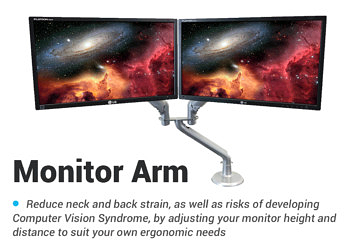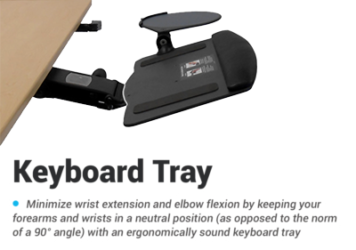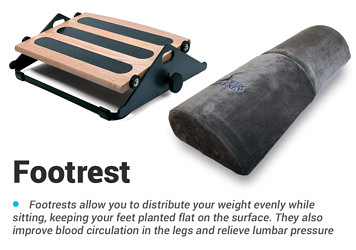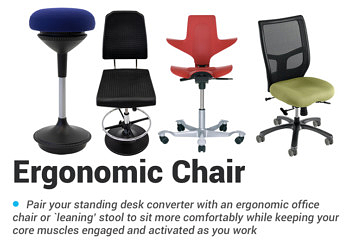Lifespan Fitness Standing Desk Review
- Forensic Review

Overview
| Review Summary |
Lifespan’s “classic” standing desks, for many years known as the DT5 (height set manually with pins) and DT7 (electric) were notoriously limited to one size, one color, and a deep cushion strip and control console that positioned the user into an atrocious ergonomic position. That’s how much this distributor of Asian-made gym equipment knew about the proper ergonomics of computer workstations when it first jumped into the office fitness industry a decade ago. To address these shortcomings Lifespan eventually introduced a more conventional standing desk that stood independently over the treadmill, but their lack of experience in standing desk furniture is once again glaring with this offering. Extremely limited in sizes and colors, it’s a commodity standing desk at a premium price, with an extremely short warranty reflective of its poor manufacturing quality. If you really wanted to buy a Lifespan treadmill base (presumably for its low price point) you’d be far better off pairing it with a desk designed specifically for walking desk ergonomics made by iMovR, and have far more decor choices as well. |
|---|---|
| MSRP / List Price | $949 |
| Street Price |
38″-wide start at $899 |
| Warranty |
Two years (compare to other desks in this price range with 15 years) |
| Lift Type |
Electric dual motor |
| Controller |
Simple digital controller with four pre-programmed height memory settings and an LCD height readout. No Bluetooth. |
| Sizes Available |
38″, 48″ and 60″ wide |
| Colors Available |
Black, Obsidian, White, Modern White, Cool Grey, Birch and Bamboo are offered but some of these are only available in one or two of the desktop widths, and will add up to $80 to the base price. |
| Monitor Arm Mounting Options |
LifespanFitness doesn’t offer monitor arms, just a “dual monitor shelf” but you can see our reviews of ergonomic monitor arms for suitable alternatives. |
| Adjustment Range |
27.5″ to 50.5″ height adjustment range. |
| Weight Capacity |
220 lbs. |
| Product Weight |
Frame: 88 lbs |
| Typical Assembly Time |
At least one hour if you have the proper tools. No downloadable instruction manual or viewable installation video is available to preview before purchase. |
| ANSI/BIFMA Certified |
No |
| NEAT™ Certified by Mayo Clinic |
No |
| Competition |
Compare to All Top-Rated Standing Desks
|
| User Reviews |
There are no published user reviews on either LifespanFitness.com’s website or Amazon, which may be an important consumer signal given how long this product has been sold. |
| Where to buy |
Buy on LifespanFitness Compare Price on Amazon |
Rating
| Ease of Assembly | |
|---|---|
| Stability | |
| Reliability | |
| Customer Experience | |
| Quality and Aesthetics | |
| Ergonomics | |
| Innovation | |
| Value | |
| Suitability for Treadmill Desking | |
| Positives | The singularly unique aspect of this standing desk is that it runs the desk's power cord through one of the lifting columns. However, your treadmill controller cable, monitor cables and all other cables will still need to be cable-managed somehow, so this doesn't really buy you anything practical. |
| Negatives | Severely overpriced for the quality, features and capabilities it offers, as compared to almost any modern-day standing desk. Short two-year warranty. Extremely limited in desktop colors and sizes. With no leg extensions available this desk would be too short for taller users working on top of a 6.5-inch-high Lifespan treadmill base. |
Bottom Line
The Lifespan Fitness Backstory
The founding editors of this website got the gumption to launch WorkWhileWalking (and WorkWhileStanding, which eventually merged into this site) back in 2012, specifically because Lifespan Fitness made a bold entry into the treadmill desk marketplace that finally legitimized it. Prior to their arrival there were only three options for someone who wanted to have a treadmill desk: a) Steelcase’s insanely overpriced and unreliable Walkstation Treadmill Desk, b) the now-defunct, incredibly poorly-made TreadDesk or Signature Treadmill Desk alternatives to the $5000 Steelcase unit, or c) taking the DIY route by hacking a rehab treadmill into a reasonably reliable, slow-speed treadmill desk.
Lifespan was the first legit player to commercialize the treadmill desk with a reasonably-priced range of products to suit almost every customer type. These included the flagship TR1200-DT3 office treadmill, the lower-cost TR800-DT3 and the heavy-duty TR5000-DT3, as well as the DT5 and DT7 integrated treadmill desk workstations with their manually and electrically height-adjustable standing desks, respectively. Tens of thousands were sold to corporations, government, education and residential home offices over the past decade. Lifespan treadmill desks would regularly appear in TV shows from The Good Wife to Alpha House.
Lifespan’s foray into active office workstations eventually attracted many competitors into the field (see our round-up review of all the under-desk treadmill bases and all the top-rated treadmill desk systems); most of which, at this stage of the game, have already joined the Dead Pool. Quite a few big brand names in cardio equipment, and a few misguided startups chased this shiny object only to find out that building and marketing a good treadmill desk would take a lot more than just removing the large pedestal console and replacing it with a desktop controller to make room for an actual desk. The only serious competitor Lifespan has ever had since 2015 has been iMovR, which stands stronger than ever with its premium-grade, enterprise-class ThermoTread GT treadmill base, and a wide array of integrated treadmill desk systems build around it such as the Lander Treadmill Desk.
Lifespan’ DNA was definitely formed in the crucible of sports equipment development, though, and this really showed in their rather pitiful offerings on the desk side of the treadmill desk combo. When asked, ergonomists shunned all treadmill desks for a long time because the Lifespan DT5 and DT7 rendition was all they’d ever seen at a trade show. Eventually Lifespan caved, and started to offer an ever-changing variety of standing desk alternatives, sourcing commodity-grade options from their factory peers in China and just bundling them with their treadmill bases. The DT5 and DT7 were eventually removed entirely from the Lifespan website, though they are still being blown out through Amazon.
At present, the only desks sold in bundles with the treadmill bases on Lifespan’s website are the generically-named Lifespan Fitness Standing Desk, which we review below. Like the DT5 and DT7 desks, the new “Power Desk” line that’s based on this desk commits the same original ergonomic sin. Between the user and their keyboard is situated a deep forearm resting cushion with an embedded console for controlling the treadmill. This forces the user into a shoulder-forward posture as they type with their upper body weight resting on their forearms to maintain stability. At least that’s how the company liked to demonstrate it at trade shows and in videos. Lifespan Fitness’ desk offerings have always been incompatible with the installation of ergonomic keyboard trays, especially the old-school DT5 and DT7 models.

While the company has never had any certificated ergonomists on staff, and always knew vastly more about working out on cardio equipment than they ever did about office workstation ergonomics, the current marketing team understands even less. Shockingly less. Perusing some of their recent social media postings we found numerous publicity shots, like this one here, that will curve your spine just looking at them. Here we have a a TR800 “Classic” treadmill desk set to a fixed sitting height, with a birch standing desk converter on top of it. For all the hardware in this photo there is no ergonomic monitor to hold up the display so the user’s neck is craning down, while the model is fake-typing in a completely unergonomic posture. What exactly is the point of putting a converter on top of an adjustable-height desk? More importantly, what is the point of using a treadmill desk in such a way as to create multiple potential ergonomic injuries? What is the point of setting a treadmill desk at sitting height, not walking height? So many questions.
Another tipoff that Lifespan’s marketing team doesn’t know the first thing about office fitness is that they’ve rebranded all their standalone treadmill bases from “-DT3”, e.g. the TR800-DT3 which they still sell on Amazon, to “Glowup” as in the TR800-Glowup that they market on their own website. (There don’t appear to be any differences between these other than the fact that the prices on the Amazon listings can be as much as several hundred dollars cheaper on some days.) But the term “glowup” really gets us, because as we’ve long said, “if you’re sweating while treadmill desking, you’re doing it wrong.”
Lifespan marketing materials often refer to walking at your desk as “a workout” instead of what it’s supposed to be: introducing healthy movement into your sedentary work routine. Sweating at your desk is anathema to the goal of treadmill desking, where you want that extra oxygen going to your brain, not your muscles. If you need some cardio exercise you should get it at the gym, not the office. As many years of Mayo Clinic research has supported, the goal is always to keep your heart rate and metabolic rate in the NEAT Zone. Perhaps this is one reason Lifespan Fitness never sought NEAT Certification; they’ve always left the top-end speed of their under-desk treadmills at 4.0 mph, way higher than the recommended 1-2.5 mph speed most office workers use, in order not to turn away customers who literally wanted to jog at their desks—with all the implied injury risks that entails.
Change of Command
Originally founded by ex-IBM sales account manager Pete Schenk after the dot-com bubble burst in the summer of 2000, the company ran with his hand on the tiller for 19 years. Not the actual manufacturer of any of these products, Salt Lake City, Utah-based Lifespan Fitness (technically, Park City Entertainment) had negotiated the exclusive distribution rights in North America and Europe for gym equipment products, and later treadmill desk and cycle desk products—all manufactured by Strength Master, a mid-tier manufacturer of cardio fitness equipment based in Taiwan and China.
It’s unclear how much ownership control the Taiwanese management team had over Lifespan prior to Schenk’s departure, but contrary to impressions the US-based company liked to put out to the world, the Utah contingent never really had much design input into the products they sold. This led to challenges over time. The company was never really in charge of its own destiny, and only had the management bench strength to be a capable distributor, not an actual technology innovation leader in the industry. The company that is always pushing the technology and ergonomic research on treadmill desks has always been, and remains iMovR. (iMovR also partnered with The Mayo Clinic to publish the only solid research on things like How Many Calories Can You Really Expect to Burn Using a Standing Desk or Treadmill Desk?)
Lifespan Fitness itself did not employ any engineers. This led to long-standing problems with some features, especially those around Bluetooth and the smartphone app, which never worked reliably and still don’t. Product reliability was always a concern because the Taiwanese factory wanted to make one treadmill base for both cardio fitness and office workstation applications. In fact, the service manuals for the office treadmills and running treadmills (e.g. TR800i, TR1200i) are exactly the same. This instigated a fundamental conflict as to where to set the gearing ratios on the motor-flywheel-pulley-head roller power transmission system. The consequence of this is that the office treadmills have never had sufficient torque at low speeds, like the 1-2 mph speed that most workstation users are walking at. This led to a shortened useful life span for the costly motor, and mounting warranty claims over the years. (We get into all the nerdy details on this issue in our primer on Do Treadmill Desk Weight Ratings Really Matter? if you want to learn more.)
From interviews with Lifespan executives over the years we learned that the company was never really on very solid financial footing. The tariffs imposed on China only affected some of the products that Strength Master made in their Chinese factory. But the pandemic, sadly, appears to have dealt a rather significant body blow to the company. In March of 2019, insiders tell us that Schenk simply “walked away from the company.” Clearly the Taiwanese are in charge of what remains of Lifespan Fitness now, with the daughter of Strength Master’s CEO moving to Utah to oversee the operation as its new CEO. More recently, we learned from a wave of departing employees that they were told by the company that they were all being summarily laid off, without warning, “due to covid.”
Ever since Schenk’s departure the company’s reputation has rapidly devolved, sad to say. Many product descriptions and specifications have been dumbed down, well-hidden or completely removed from the website. There is no phone number to call (and when we called the number we had for the company we just went into a hold queue forever before being invited to leave voicemail). Lucy the live chat bot is badly programmed, and doesn’t know how to answer a single question about the treadmill desk products, only classroom products and gym equipment. The only way to communicate with the company appears to be through email, and we’ve read numerous user complaints on various networks like the BBB about customers not getting any kind of response on warranty claims and other issues. Places, that is, where Lifespan couldn’t scrub out bad reviews, as they can on their own website.
Lifespan Fitness doesn’t feel like the same company we knew so well in the formative years of the treadmill desk industry. It is sad to see what remains of its remote controlled husk today. The product offerings appear to have been thinned out and maximally cost-reduced, and the warranties have been completely removed from the treadmills. If you want a warranty on your treadmill you now have to buy it as an “extended warranty” upgrade. Calling it an “extended warranty” implies that there’s some standard manufacturer’s warranty that it is adding more years to, but there is none documented anywhere on the website any longer. What used to be the standard warranty for the first decade that these products were sold in the USA is now the minimum extended warranty you can tack on for $270.
We suppose that’s one way to keep prices down in the face of tariffs and rampant deep ocean freight cost increases since the pandemic, but we simply can’t recommend any product that has no standard warranty at all. These aren’t $20 phone chargers, they’re $1,000 – $3,000 treadmills and treadmill desks. Caveat emptor should you choose to plunk down your cold hard cash on a Lifespan Fitness product today. (Note that we do find the original TR800, TR1200 and TR5000 treadmills, in DT3 (standalone base), DT5 (with manually-fixed height setting) and DT7 (with electric height setting) still being sold on Amazon. It’s unclear whether or not these are sold with an intact manufacturer’s warranty; none is mentioned in the Amazon listings but neither are the extended warranty options. Buying through Amazon may at least give you a modicum of consumer protection if you have a problem in the first 30 days.)
Not surprisingly, Lifespan’s website traffic has also been notably degraded since the pandemic, at a time when fitness equipment, treadmill desk and standing desk categories are all booming. We used to know many of the people in the organization from trade shows and other interactions; almost to a one have moved on to other employment over the past few years. These days we learn much more about goings on at the company from departed employees than from anyone still in active management. It is a bit depressing to see the most recognized pioneer in popularizing the treadmill desk concept fall so far from its perch.
Onto the review of the Lifespan Fitness Standing Desk…
An Underwhelming Standing Desk at a Premium Price
Given the updated backstory above, we’re publishing the following as a forensic review, not one of our full lab test reviews (read about how we test the products we review). Given how many hundreds of standing desks are in the market today we cannot bring every one of them into our Bellevue test labs to put through their paces. And we’ve never had a single reader request a review of this product, either. In fact, this product has no user reviews on Lifespanfitness.com’s own website, nor on Amazon, which is a rather telling indicator.
However, there’s much that we can say about how the product compares to the competition simply by analyzing the specifications, photographs and details we’re familiar with from common OEM components that go into it.

The first thing to note is the limited sizes this desk comes in: 38″, 48″ and 60″. While you can find standing desks designed for “sit-stand-walk workstations” that go as wide as 95″ (e.g. the Lander), you will never fit a chair next to your treadmill using any of these narrow desks. If you want to change from walking to sitting you’ll have to switch desks or pick up one of the treadtop chairs we’ve reviewed.
Next, you’ll note that the desktops come in very few colors. Fewer still when you realize that some of them only come in one or two of the three sizes. With all the supply chain challenges hitting Asian manufacturers these days it could just be that these are temporarily out of stock but there’s woefully little information to go on from the company’s website, let alone Amazon, and you can’t ask anyone a question like that in live chat. Lucy is very restricted on what kinds of questions she can answer. The quality of the desktops is commodity grade, 1″-thick high pressure laminate and powder coat, though they don’t say which colors are which type. (Learn about all the different materials used to make desktops for standing desks.) There is nothing fancy here like ergo-contoured 3D-laminated surfaces, though for this kind of money you’d explain at least that much.

The controller is a simple affair with an LCD screen for the height readout and four programmable desk height memories, but no Bluetooth interface or smartphone app. That’s probably OK given that Lifespan’s treadmills that feature Bluetooth have never worked properly with their app, but for this kind of money you’d expect the premium feature.
With a height range of 27.5″ to 50.5″ the Lifespan Fitness Standing Desk would be in the same range as other modern standing desks, but given that their treadmill bases are 7.25″ tall the effective top-end height setting is a relative 43.25″ high. That’s not enough for tall users, and will lead to a shaky typing experience for many users simply because there will be little remaining overlap at the ends of the telescoping tubes in the lifting columns when the desk is raised to its top heights. More serious treadmill desk manufacturers like iMovR offer 6-inch leg extension kits specifically for this reason, and it’s remarkable to us that after more than seven years Lifespan has not copied this adaptation.

The only point of distinction about this desk, if there is one at all, is that it conceals the desk’s own power cord inside the left lifting column. That may seem kind of cool at first blush but there are a couple of problems with it. First, every other OEM standing desk base manufacturer has avoided this design because all kinds of things can go wrong with that power cord sharing the same channel as the spindle. Second, the benefit is meaningless to a computer user that still has to have other power cords come down somehow from the desktop. There are a variety of good desk cable management kits we’ve reviewed that will do the trick without this reliability risk from running just one cord through the leg. For a treadmill desk user, there’s the additional cable running up to the desktop controller from the treadmill base, which of course is not addressed in this Rube Goldberg design, either.
The Takeaway
It’s very sad for us to update these Lifespan reviews with news that the company is not what it once was, and that we can no longer recommend them after having helped thousands of treadmill desking newbies get going with a Lifespan workstation over the past decade. This inferior, albeit highly over-priced desk, is a symptom of the general problem with the company’s products these days. And in a field where $1,000 can get you a top-tier American-made standing desk with 3D-laminated surfaces in a huge array of sizes and colors and even a 15-year warranty, it’s impossible to recommend something so basic and only backed by a two-year warranty from a company that doesn’t provide a phone number for sales or support.
The fact that there doesn’t appear to be a single user review or 3rd party review of this desk anywhere on the internet is a good sign; hopefully, consumers have been savvy enough to come to the obvious conclusion about its poor value proposition all on their own.
Many standing desks and converters come with grommets for some added convenience. Check out our article on grommet holes for everything you need to know about the different ways to use them to enhance your workstation, what to look for in your grommet holes, and where to find the desks with the best ones.





0 Comments
Leave a response >